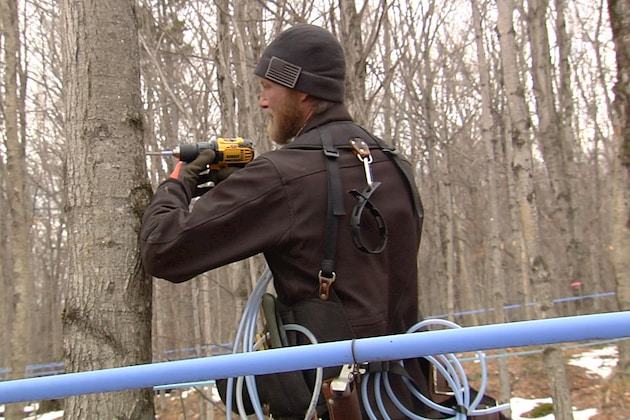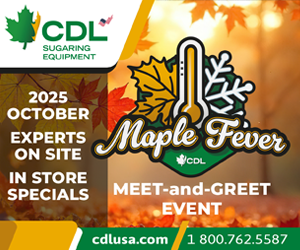UVM Proctor Page
Stay away from the dead wood when tapping say Vermont researchers
Online webinar teaches tapping tips
By PAUL POST | OCTOBER 20, 2020
UNDERHILL CTR., Vt.—Stay away from the dead wood.
Sugarmakers should maintain a large amount of clean, conductive wood in their trees, which will make sure the tree has a functional water transport system and is at relatively low risk of disease and decay.
That was the message from industry expert Abby van den Berg, University of Vermont research associate professor and assistant director of the Proctor Maple Research Center.
She was the host “Tapping Practices to Optimize Sustainability and Yields,” a webinar hosted by the Virginia Tree Syrup Program last month.
“But it also means we have a high probability of hitting clean, conductive wood when we tap,” van den Berg said. “That means we’re going to maintain sustainability of yields as well.”
Promoting healthy, radiant growth of trees is the underlying basis for ensuring maple production’s long-term success and profitability.
“We can define sustainable as a condition where the addition of new conductive wood outpaces the amount of non-conductive wood generated by tapping and the total amount of conductive wood in the tapping zone remains high,” she said. “If we meet that condition it give us sustainability not just for tree health, but sap yield.”
Producers should always focus on trying to optimize rather than maximize yields, a subtle, but distinct and extremely important difference, she said.
“We need to find a balance point between the two, so that yields are maximized over the long term,” van den Berg said. “Everything circles back to what’s going on with your trees and how well the trees are growing. That’s the starting place for everything.
"There’s a lot we can do with trees that don’t even have great growth rates, to not only improve growth rates, but make sure we’re getting the best growth while working around the buildup up of non-conductive wood in that tree,” she said.
She suggested ways tapping practices can be adjusted, without impacting current yields, to increase the tapping zone so there will be more conductive wood to begin with, affording a better chance of hitting clean wood.
In one study, for example, simply extending drop lines six inches from 30 to 36 inches greatly increased the amount of conductive wood available to tap in each tree, and increased the number of trees needed to meet the stand’s sustainability threshold.
She also encouraged producers with a pump vacuum system to tap below lateral lines, which can open up a whole new area of clean wood. This is a particularly good strategy to use for older trees that likely have significant amounts of non-conductive wood.
“This can double the size of your tapping zone,” van den Berg said. “We have a lot of enormous trees at the Proctor Center that have been tapped since the mid-1800. When we switched to tapping below the lateral line the rate of hitting non-conductive wood dropped from 15 to five percent.”
“Once you’ve exhausted these options then you adjust practices that do impact current yields like reducing tapping depth, spout size and number of taps per tree,” she said. “Tapping practices today ultimately determine yields of the future, not just today.”
Using slightly shallower, smaller taps might impact yield somewhat, but the positive tradeoff is that there’s less strained wood in a tree, which can produce major financial benefits over the long run.
In another study involving 5,000 taps, stained wood was hit 4.5 percent of the time, causing an estimated loss of 70 cents per tap. By adjusting tapping practices, stained wood was only hit one percent of the time, a 3.5 percent reduction, which saw losses drop from 70 to 15 percents per tap.
“We were no longer losing $2,800 per year just by reducing the frequency of hitting stained wood,” van den Berg said.
But long before all this, healthy tree growth which increases clean, conductive wood can be improved by adopting sound woodlands management practices.
“In most cases this is going to mean getting out the chainsaw and doing some thinning,” van den Berg said. “I can’t recommend enough the importance of working with a forester to get a management plan for your stand. It can be super helpful, save a lot of money and make sure yields are optimized in the long run.”
It’s also vitally important to take care of soil by doing a good job of logging because “a bad logging job can do tremendous damage to your crop trees,” she said.
There is no hard and fast rule for deciding when to start tapping smaller, young trees, although with smaller trees, the column of non-conductive wood produced by tapping takes up a much bigger proportion of the tapping zone.
Yield typically increases with size, about a half-pound of sap per inch of tree diameter, said van den Berg. She is currently conducting a study that will hopefully provide helpful data about when smaller trees should first be tapped.
“In most cases it’s going to be situational,” she said. “A lot of trees on the smaller end aren’t main canopy trees, so they’ve got not-so-great growth rates. In this case, an eight- or nine-inch tree with a poor growth rate may not be appropriate to tap. But if there’s a stand with eight- or nine-inch trees that have great growth rates, they’re part of the main canopy, have good exposure and good soils, those are probably fine to tap.”
“It really does depend on the situation,” van den Berg said. “Not every eight- or nine-inch tree is going to be like it’s neighbor. It really comes down to growth rates and health for sure.”
For a schedule of other upcoming online events go to the Proctor Maple Research Center website: www.uvm.edu/pmrc.

































